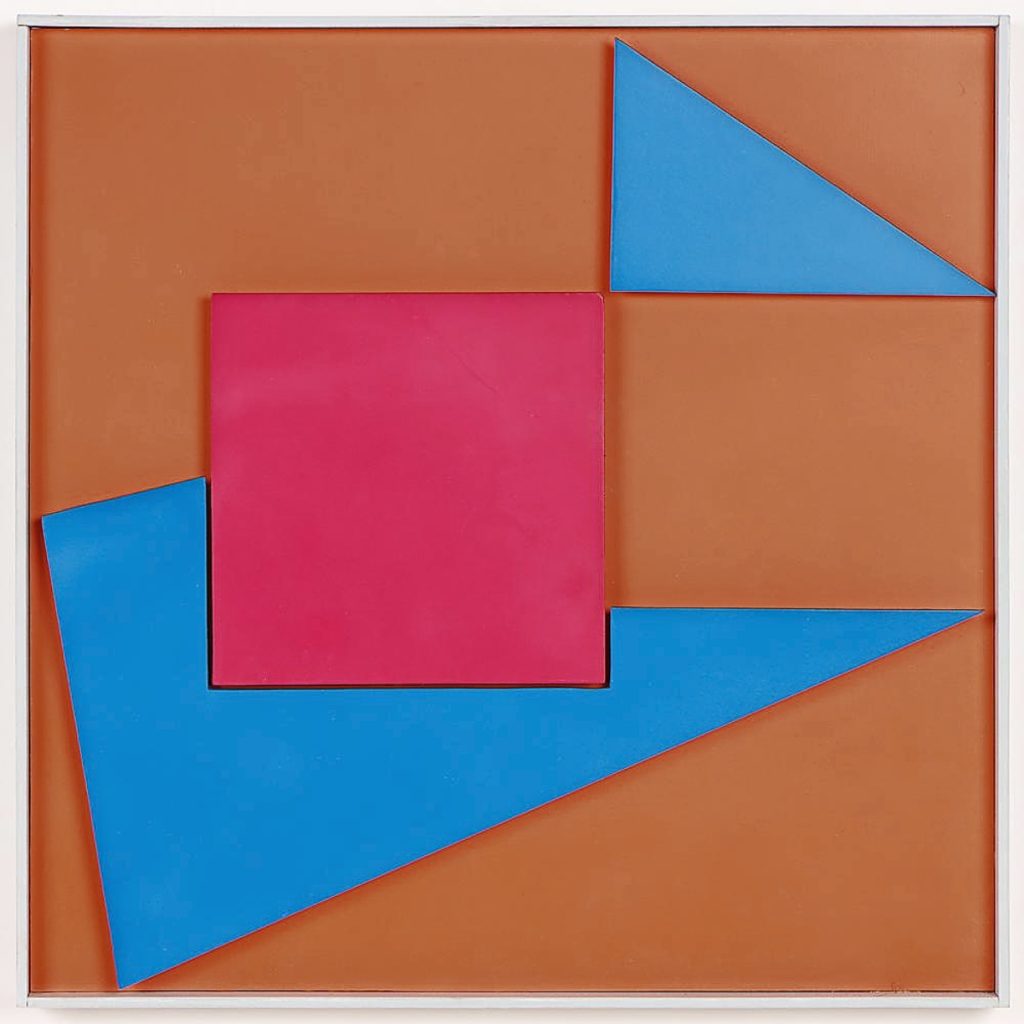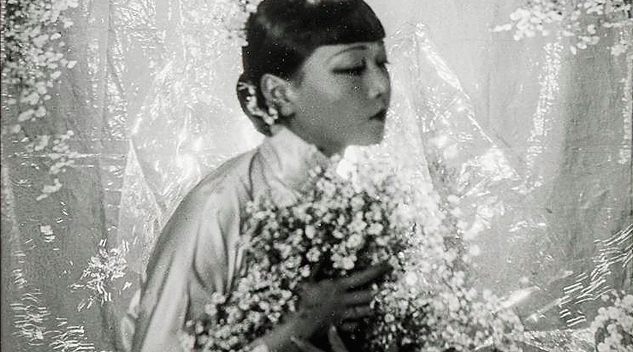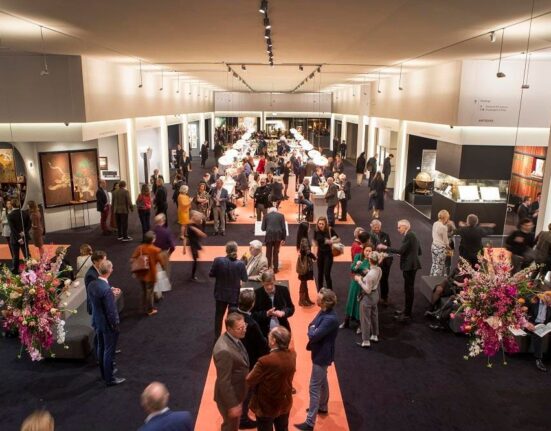
Untitled acrylic relief on panel by Henryk Stanewski, signed and dated 1970, led the sale at $23,040 and almost quadrupled its high estimate ($3/6,000).
Review by Z.G. Burnett, Photos Courtesy of Material Culture
PHILADELPHIA – Material Culture’s Fine, Folk & Outsider auction took place on November 21, offering more than 500 lots from a diverse range of schools, origins and mediums. The upper lots were mainly fine paintings and works on paper, with a few examples of folk art and contemporary design.
Somewhere between painting and sculpture, the top lot was an acrylic relief painting by Henryk Stazewski (Polish, 1894-1988) that bid to $23,040 online. Stazewski was an avant-garde pioneer of the Twentieth Century as an early representative of many artistic movements, including Suprematism and Constructivism, and was a co-creator of the Geometric Abstract movement. He studied in Paris during the 1920s and 1930s then returned to acclaim in Poland, but was unable to work during the German occupation. During this time, almost all of his early work was destroyed. After the war Stazewski returned to geometric abstract expressionism, making his first reliefs in black and white in the 1950s and expanding his palette to color in 1967. This relief is an example of that late period, dated 1970.
Another abstract expressionist in the top lots was Nasreen Mohamedi (Indian, 1937-1990), whose ink on paper composition sold to an internet bidder for $3,200. Considered one of the most significant artists of the post-Independence period, Mohamedi was the subject of a retrospective at the Metropolitan Museum of Art in 2016. She infrequently exhibited in her lifetime but worked in a variety of mediums exploring light and shade, as well as geometric, non-representational forms. Mohamedi rarely signed or dated her work, as was the case with this unframed work on paper.
There were a few examples of European fine and decorative art in the higher priced offerings, which included a carved wood sphinx that bid to $9,375 and earned second place in the top lots. From an estate collection in Philadelphia, the sphinx showed cracks and other signs of wear concurrent with its age but was no less alluring to its buyer. Another mysterious figure was an Eighteenth Century English school portrait of a young girl from a Pittsburgh collection that far exceeded its $400/800 estimate, selling to a single online bidder for $2,375.

One of the few antique European top lots, this carved wood sphinx came from a Philadelphia estate collection and was the second highest selling object at $9,375 ($1/1,500).
There was a large collection of Haitian art up for sale, including the third highest selling lot, “Departure of the Fisherman” by Lyonel Laurenceau (b 1942). Emphasizing emotion with rhythm, color and light, Laurenceau won first prize at the New York City World’s Fair in 1966 and is represented in the collections of more than 50 museums worldwide. This painting was previously sold by Christie’s and Butterscotch Auctions, and achieved $7,040. Wilson Bigaud (1931-2010) had eight paintings up for auction, each showing scenes of daily life in Haiti. The most successful of these was “Swimming Pool,” displaying a lively party in oil on Masonite, which sold for $3,000.
African American artists were also prominent in the top lots. “Checkers” by Philadelphia artist Andrew Turner (1944-2001) exhibits how the artist focused on “common folk activities,” influenced by Seventeenth Century Dutch genre scenes with the deft brushwork of an impressionistic hand. The scene of men playing checkers on a sunny afternoon played out to $5,000. A lithograph by Jacob Lawrence (1917-2000) represented a different style of social realism, titled “Builders Three.” Using sharp angles and primary colors, the high-energy image earned $3,750.
Out of the 23 portraits in the sale by English photographers, the highest earning was a large format printing of Anna May Wong (American, 1905-1961) that was stamped and signed by Cecil Beaton. Wong was the first Chinese American movie star and the first Asian American woman to have a star dedicated to her on Hollywood’s Walk of Fame. Despite being a third-generation American, Wong had to navigate the American film industry’s inherent racism that limited her to “Dragon Lady” parts and supporting roles, while Caucasian actresses were cast as leads for Asian characters. Wong moved overseas where she became a leading lady of the European stage and screen, but never achieved the same acclaim in the United States. Here Beaton, photographer to royalty and high society of the age, shows Wong in contrast to her typecast roles; contemplative rather than intense and seductive, she wears soft, light clothes and delicately holds a bouquet of flowers, emphasizing her celebrated hands. The photograph sold online for $4,480.

“Anna May Wong,” signed by photographer Cecil Beaton, clutched $4,480 ($1/1,500).
The self-portrait of another expatriate, Léonard Tsuguharu Foujita (Japanese, 1886-1968), followed the Beaton photograph in price at $3,500. Foujita arrived in Paris shortly after graduating from art school in Tokyo and almost immediately became part of the avant-garde inner circle. Known for creating paintings and lithographs of contemporary European subjects using traditional Japanese materials and techniques, Foujita was also a great cat lover. In this lithograph, Foujita includes an animated pet tabby that appears in many of his self-portraits and in photographs of the artist. Foujita would often paint cats into portraits and many felines were themselves subjects of his portraiture.
A living veteran of this era appeared in the sale; a gouache still life by French painter Françoise Gilot, who turned 101 on November 26, sold for $2,688 to an online bidder. Gilot’s name is recognized for her association with Pablo Picasso, a partnership that produced two children, Paloma and Claude. Forty years his junior, Gilot met Picasso when she was 21 and became one in a series of his raucous, dramatic relationships. Already an exhibited young artist by the time she met him, Gilot considers her association with him and the celebrity it brought to have been a hinderance to her career. After she left Picasso, he dissuaded gallerists from exhibiting Gilot’s work and tried to block her memoirs of life with him from publication. Failing this, he refused to see their children, beginning a long legal battle to have them declared as heirs to his estate. Gilot continued to create, and her 1965 portrait of Paloma sold at Sotheby’s in London for $1.3 million in 2021.
Animal art also did well in the sale, with two anonymous works charming bidders by their appearance alone. The first was a painting of an ostrich from the Nineteenth Century, designated “orientalist” due to the desert-like fauna in the background. From the collection of late art dealer T. Gilbert Brouillette (American, 1906-1970), the ostrich portrait bid to $3,375. Bounding behind this was a dynamic Korean folk painting of a tiger and two magpies that achieved $2,304 online. The painting came from the Jim and Kit Horne collection, whose estate auction was conducted at Material Culture on March 27, 2022.
Prices quoted with buyer’s premium as reported by the auction house. Material Culture’s Big Tent 2 Estates sale will occur on December 14. For information, 215-438-4700 or www.materialculture.com.







